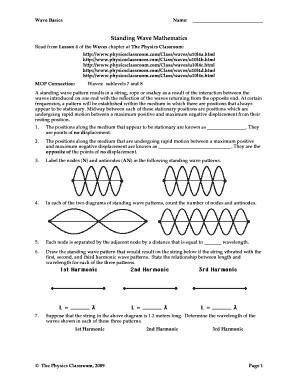
Get Standing Wave Mathematics Answers
How it works
-
Open form follow the instructions
-
Easily sign the form with your finger
-
Send filled & signed form or save
How to fill out the Standing Wave Mathematics Answers online
Filling out the Standing Wave Mathematics Answers online can streamline your learning process and enhance your understanding of wave behavior. This guide provides clear, step-by-step instructions designed to help users complete the form accurately and efficiently.
Follow the steps to fill out the Standing Wave Mathematics Answers form online.
- Click ‘Get Form’ button to obtain the form and open it in the online editor.
- Begin by entering your name in the designated field at the top of the form. This information is necessary for identification purposes.
- Proceed to the questions section, starting with the first question regarding the points of no displacement. Carefully read and input your answer as it relates to the wave patterns.
- Continue to the second question, focusing on the opposite of the points of no displacement. Fill this section out thoughtfully, ensuring accuracy.
- In the next section, label the nodes and antinodes in the provided diagrams accurately. Use the labels 'N' for nodes and 'AN' for antinodes.
- Move on to count and record the number of nodes and antinodes from the diagrams. Double-check your counts to ensure correctness.
- Answer the question regarding the distance between nodes. Specify how the distance relates to the wavelength as required.
- For the drawing section, illustrate the standing wave patterns for the first, second, and third harmonics as specified and document the relationship between length and wavelength.
- Next, calculate the wavelength for each of the harmonic patterns based on the given string length of 1.2 meters.
- Complete calculations for the string lengths mentioned, including frequency, period, wavelength, and speed for each scenario presented in the additional sections.
- Once all sections are filled out, review your answers for accuracy and completeness. Make necessary corrections.
- Save your changes, and then choose to download, print, or share the filled-out form as needed.
Start completing your forms online today for a more efficient process!
Fill Standing Wave Mathematics Answers
A standing wave has formed which has seven nodes including the endpoints. What is the frequency of this wave? For standing wave patterns, there is a clear mathematical relationship between the length of a string and the wavelength of the wave that creates the pattern. What is the phase difference between particles at adjacent nodes in a standing wave? The phase difference is π radians (or 180o). A standing wave is the result of two waves of the same frequency and amplitude traveling in opposite directions. The rod is struck in such a way as to produce a fundamental longitudinal standing wave. (a) Show that the wavelength of the wave is 0.800 m.
Industry-leading security and compliance
-
In businnes since 199725+ years providing professional legal documents.
-
Accredited businessGuarantees that a business meets BBB accreditation standards in the US and Canada.
-
Secured by BraintreeValidated Level 1 PCI DSS compliant payment gateway that accepts most major credit and debit card brands from across the globe.


